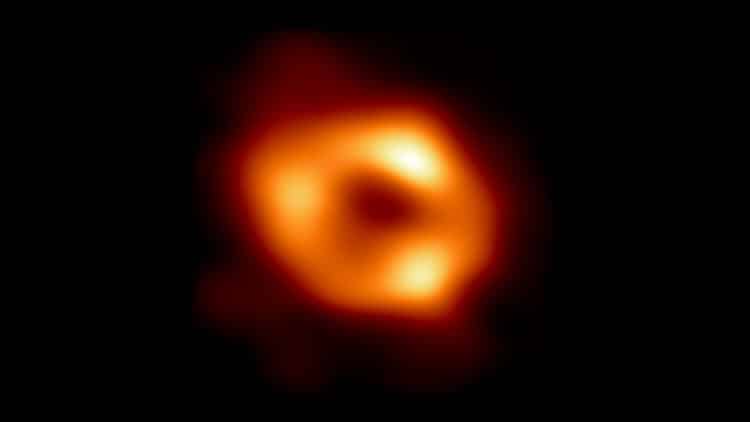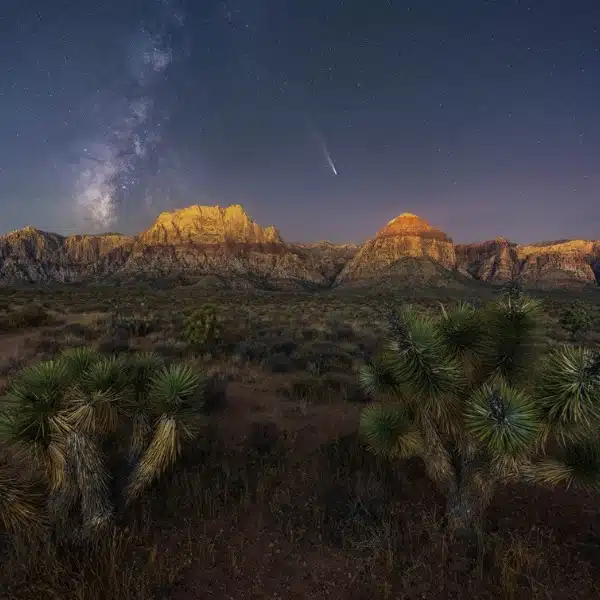
The Event Horizon Telescope (EHT) collaboration, who produced the first ever image of our Milky Way black hole released in 2022, has captured a new view of the massive object at the center of our Galaxy: how it looks in polarized light. This is the first time astronomers have been able to measure polarization, a signature of magnetic fields, this close to the edge of Sagittarius A*. This image shows the polarized view of the Milky Way black hole. The lines mark the orientation of polarization, which is related to the magnetic field around the shadow of the black hole. Image (Photo: EHT Collaboration, CC BY-NC-SA)
Black holes are points in space where gravity is so strong that nothing can escape, not even light. They are intriguing mysteries to astronomers and science-fiction fans alike. Thanks to the work of an international collaboration, we're one step closer to better understanding exactly how black holes work. And the more we know about them, the more we can unravel about the history of our own little galaxy, the Milky Way.
While black holes were predicted by Albert Einstein's theory of general relativity in 1915, our first images of black holes only came to be this century. In 2019, the Event Horizon Telescope (EHT) Collaboration published an image that was made from direct observations of the Messier 87 galaxy's black hole, M 87*, made in 2017. In 2022, they released their first images of our local black hole Sagittarius A* (aka Sgr A*, which is read as Sagittarius A star). Those images were both produced by observing radio waves around the edge, or event horizon, of the black holes. However, each year brings technological advances to the EHT Collaboration. Last month, the first polarized image of our black hole was released in The Astrophysical Journal Letters, revealing a mesmerizing magnetic field that appears to spiral out.
Observing the polarized light waves of Sgr A* lets scientists chart the magnetic fields close to the black hole. This step forward unlocks new understanding of how black holes work. Astronomers happened upon a surprise because this polarized image is similar to an earlier polarized image of the M 87* black hole. Both black holes appear to have magnetic fields that are similarly organized and have comparable behaviors. This is telling, because M 87* and Sgr A* are very different black holes in term of size and surroundings. While Sgr A* is 4.3 million times as big as our Sun, M 87* is 6.5 billion times as big. This size difference is part of the reason why it was much harder to capture an image of Sgr A* despite it being only 27,000 light-years away from Earth, compared to M 87* which is 53.5 million light-years away. While particles on their edges move at similar speeds, it take exponentially longer for particles to finish whipping around M 87*. Also notable, M 87* is surrounded by more gas and dust.
Despite these differences, the similar magnetic fields suggest that all black holes are governed by the same physical processes. It also suggests that the Milky Way's black hole contains a jet, which is a powerful outflow of energy. A jet is the most energetic mechanism in the entire universe, and its clearing out of gas and dust helps give way to stars and galaxies. Indeed, learning that Sgr A* likely has a jet alters scientists' understanding of how the Milky Way came to be.
Of course, there is still much more to learn about our home galaxy and the universe itself. Each year, technological advances help the EHT Collaboration deepen their understanding of black holes. For the EHT Collaboration—an international consortium of astronomy programs and telescopes ranging from the Atacama desert to the South Pole—each telescope contributes to their “very long baseline interferometry.” This interferometry uses data taken from across the planet at different angles and times to create a fuller image and essentially act as an Earth-sized telescope. Each year, the Collaboration is adding telescopes and bandwidth, providing astronomers with more data. It will once again be observing Sgr A* this month.
In the decade to come, there are hopes to have multicolored views of event horizons, as well as high-fidelity footage. There is even potential to add telescopes in outer space to add to the EHT data. It is fitting that we can only understand our place in the universe by coming together as a planet. After all, even national borders cannot escape a black hole.
New images of the magnetic fields of the Milky Way's black hole, Sagittarius A* were released by the Event Horizon Telescope Collaboration.

Seen here in polarized light, this side-by-side image of the supermassive black holes M87* and Sagittarius A* indicates to scientists that these beasts have similar magnetic field structures. This is significant because it suggests that the physical processes that govern how a black hole feeds and launches a jet may be universal features amongst supermassive black holes. (Photo: EHT Collaboration, CC BY-NC-SA)
The image demonstrates that Sagittarius A* acts similarly to a much bigger black hole, the M87*.

At left, the supermassive black hole at the center of the Milky Way Galaxy, Sagittarius A*, is seen in polarized light, the visible lines indicating the orientation of polarization, which is related to the magnetic field around the shadow of the black hole. At center, the polarized emission from the center of the Milky Way, as captured by SOFIA. At back right, the Planck Collaboration mapped polarized emission from dust across the Milky Way. (Photo: S. Issaoun/EHT Collaboration, CC BY-NC-SA)
Using polarized light, astronomers now have a better understanding of Sagittarius A* and our home galaxy, the Milky Way.

This is the first image of Sgr A*, the supermassive black hole at the centre of our galaxy, with an added black background to fit wider screens. It’s the first direct visual evidence of the presence of this black hole. It was captured by the Event Horizon Telescope (EHT), an array which linked together eight existing radio observatories across the planet to form a single “Earth-sized” virtual telescope. The telescope is named after the event horizon, the boundary of the black hole beyond which no light can escape. Although we cannot see the event horizon itself, because it cannot emit light, glowing gas orbiting around the black hole reveals a telltale signature: a dark central region (called a shadow) surrounded by a bright ring-like structure. The new view captures light bent by the powerful gravity of the black hole, which is four million times more massive than our Sun. The image of the Sgr A* black hole is an average of the different images the EHT Collaboration has extracted from its 2017 observations. In addition to other facilities, the EHT network of radio observatories that made this image possible includes the Atacama Large Millimeter/submillimeter Array (ALMA) and the Atacama Pathfinder EXperiment (APEX) in the Atacama Desert in Chile, co-owned and co-operated by ESO is a partner on behalf of its member states in Europe. (Photo: EHT collaboration/European Southern Observatory, CC BY-NC-SA)
The Event Horizon Telescope collaboration is a worldwide effort made up of telescopes across the entire Earth.

A global map showing the radio observatories that form the Event Horizon Telescope (EHT) network used to image the Milky Way’s central black hole, Sagittarius A*. The telescopes highlighted in yellow were part of the EHT network during the observations of Sagittarius A* in 2017. These include the Atacama Large Millimeter/submillimeter Array (ALMA), the Atacama Pathfinder EXperiment (APEX), IRAM 30-meter telescope, James Clark Maxwell Telescope (JCMT), Large Millimeter Telescope (LMT), Submillimeter Array (SMA), Submillimetere Telescope (SMT) and South Pole Telescope (SPT). Highlighted in blue are the three telescopes added to the EHT Collaboration after 2018: the Greenland Telescope, the NOrthern Extended Millimeter Array (NOEMA) in France, and the UArizona ARO 12-meter Telescope at Kitt Peak. (Photo: M. Kornmesser/European Southern Observatory, CC BY-NC-SA)
h/t: [PetaPixel]
All Images via Event Horizon Telescope Collaboration and European Southern Observatory.
Related Articles:
Astronomers Successfully Image the Magnetic Field at the Edge of a Black Hole
Supermassive Black Hole Speeding Through Universe Is Creating Stars
James Webb Space Telescope’s Findings Confirm We Know Very Little About Our Universe
Digital Atlas of Over 380,000 Galaxies Is Made Available Online






















































































